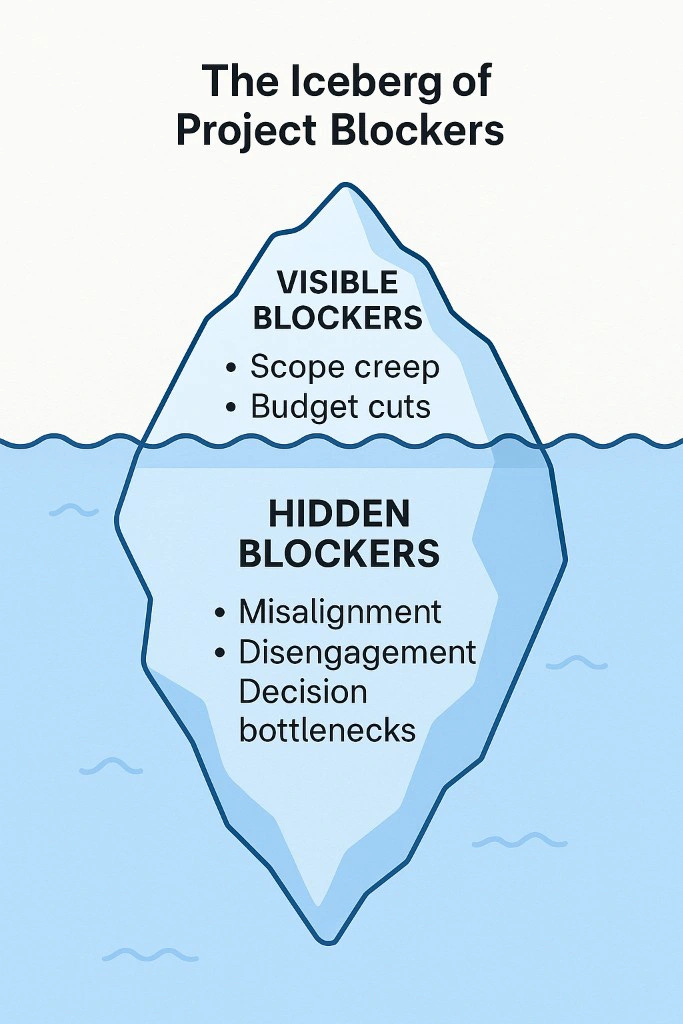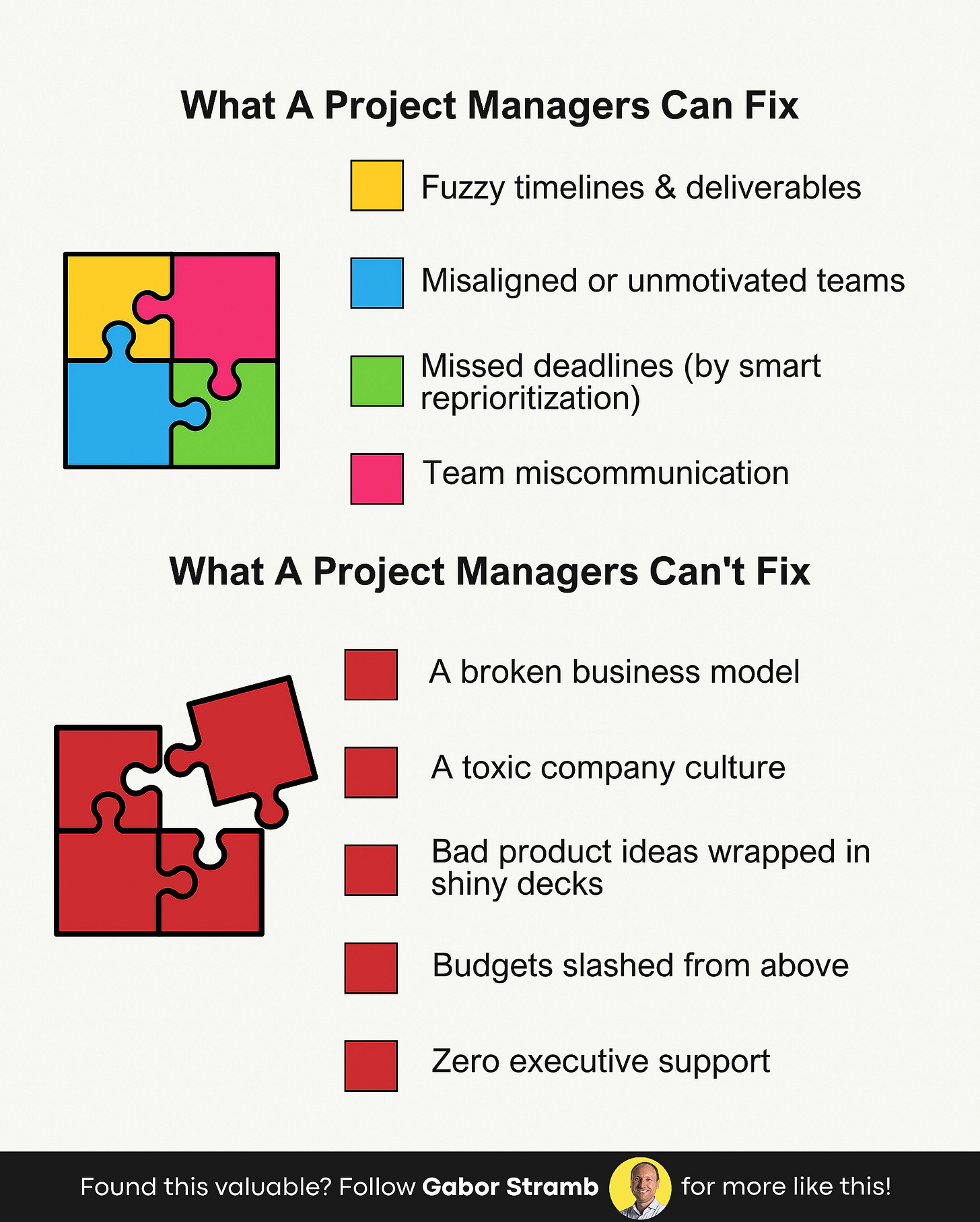Can’t predict the future, when the future is changing
Most companies don’t have a project management problem. They have a leadership problem.
Welcome to the Agile Admiral weekly newsletter. Your Essential Resource for Project Management Excellence.
Each week, I tackle reader questions about PMP preparation, how to implement PMP into real-life projects, and a Senior Project Manager career.
For more: Delegating as a PM: What to unlearn? | The Chaos Coordinator | The Project Habit You’re Probably Skipping | When Projects turn RED | Macro vs Micro Goals for PMs | PM without authority is just a punching bag with a calendar | Agile without psychological safety is just a Theater
What's Inside This Edition:
The Hidden Blockers Project Managers Face (That No One Talks About)
Can’t predict the future, when the future is changing on a daily basis
What’s new at PMI?
The Hidden Blockers Project Managers Face (That No One Talks About)
by Doha Mohsen
Project managers are often considered to be people who can deliver the impossible. We align the team, change what needs to be changed, set dates, and deliver on demand. However, some of the most critical blockers we face rarely find their way into project plans or RAID logs. They're precise, systemic, and frequently invisible—until it's too late. In this blog, I’m not going to talk about scope creep, missed deadlines, or poor requirements. Instead, I want to highlight the hidden blockers—the ones that stem from people, culture, and communication and offer practical ways to overcome them.
A common visual to illustrate this is “The Iceberg of Project Blockers,” where observable blockers like scope creep or budget cuts appear above the surface, while deeper issues such as lack of alignment, disengagement, and decision bottlenecks lurk below.
Take alignment, for instance. In the early stages, everyone nods in agreement. But weeks later, teams define “done” differently, leading to rework. This often happens because speed is prioritized over clarity, and departmental interpretations differ. To react to this, project managers should facilitate expectation check-ins, get teams to define critical terms, and use visual alignment tools like Miro.
Another frequent challenge is the invisible decision-maker—someone who hasn't been involved but suddenly reverses a key choice. This is often due to poor stakeholder identification or internal politics. Thus, PMs must treat stakeholder mapping as a must-have, keep an “influence radar,” and revisit it regularly.
Then there’s silent resistance team members who agree verbally but don’t follow through. It’s not always resistance; it can be confusion, fear, or burnout. Managers should foster open dialogue, observe behavior closely, and lead by example through vulnerability and transparency.
Shifting priorities also wreak destruction when they’re not reprioritized. What’s urgent today becomes background noise tomorrow, derailing momentum. To counteract this, PMs must challenge changes constructively, use flexible backlog systems, and set clear WIP limits with leadership.
A passive sponsor or product owner is another hidden risk. Their absence or disengagement can stall progress. Clarifying their role and ensuring regular check-ins, even short ones, can maintain alignment. Escalation may sometimes be needed to reemphasize their importance.
Hidden organizational politics can be particularly insidious. Teams may act flexible in meetings but stall progress behind the scenes. By identifying internal allies, publicly celebrating cross-team wins, and using neutral facilitation methods, PMs can build a more collaborative culture.
Lastly, an over-reliance on tools while seeming efficient can actually hinder communication. Tools should support discussions, not replace them. Encouraging quick, informal check-ins and choosing user-friendly systems that enhance clarity is key.
Most project blockers don’t explode; they leak quietly. Exceptional project managers do more than coordinate tasks. They observe, listen, and act before issues escalate. We can’t eliminate every obstacle, but we can lead proactively through them. That’s the hallmark of resilient delivery, not reactive firefighting.
Most companies don’t have a project management problem. They have a leadership problem.
Here’s what Project Managers can fix:
• Team miscommunication
• Fuzzy timelines & deliverables
• Resource bottlenecks
• Scope creep (with stakeholder buy-in)
• Missed deadlines (by smart reprioritization)
• Misaligned or unmotivated teams
But here’s what we can’t fix (and nobody wants to admit this): • A broken business model
• Stakeholders living in fantasyland
• Zero executive support
• Bad product ideas wrapped in shiny decks
• A toxic company culture
• Budgets slashed from above
Let’s stop expecting PMs to clean up strategic messes made in boardrooms.
We’re not miracle workers. We’re not therapists. We’re not magicians.
We are operators. And we thrive when leadership does its job.
If you’re a PM: protect your energy. If you’re in leadership, do better.
Enterprise Insights for Organizational Excellence
We’re empowering organizations to thrive in a rapidly evolving business landscape. With cutting-edge research, real-world case studies, expert commentary, and forward-thinking podcasts, PMI delivers the insights and strategies that drive enterprise success—today and into the future.
Start exploring how the world’s leading organizations are transforming project management to accelerate performance, build strategic alignment, and lead with impact:
Connect on LinkedIn: Follow PMI Enterprise Solutions to stay ahead with the latest research, trends, and strategies. Learn how high-performing organizations are building resilient teams and driving measurable business outcomes. Join the conversation on LinkedIn
Explore Research and Insights: Access executive-level content on what it takes to lead successful projects and shape the future of work. From real-world case studies to expert perspectives, this hub is your source for enterprise-ready knowledge. Explore more
Read the Deloitte Case Study: See how Deloitte partnered with PMI to align talent with strategy, scale execution, and future-proof its workforce. Through targeted certifications and custom training, they unlocked greater value and organizational resilience. Read the full story
Continue reading here: PMI Newsletter
Thank you for reading. Appreciate you!
Let’s win together,
Follow me on LinkedIn | YouTube
If you’re interested in any of the products or services I offer, here’s a quick recap:
👉🏼Do it together - join the PMP Operation System
👉🏼Do it 1-on-1 - join 8-week coaching program
https://gaborstramb.com/special-offer







Really liked reading this. I think people forget that good leadership is what gives a project room to work well. Without that, PMs just spend time patching holes. I always try to remind teams that if you want better delivery you need better direction first.